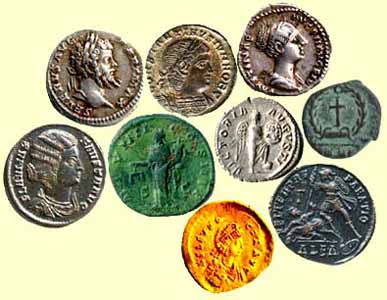Roman Coins

Roman Coins
Roman Coin History
By Josh White - Ezinearticles
Paying for goods and services in Rome didn't start with the coin but certainly ended there. Before the common use of the coin was an economy that operated on the bartering of livestock. Then, came the early coinage in the form of bronze bars around 289 B.C. From here things began to change with the creation of 'change' and it never turned back.
By Josh White - Ezinearticles
Paying for goods and services in Rome didn't start with the coin but certainly ended there. Before the common use of the coin was an economy that operated on the bartering of livestock. Then, came the early coinage in the form of bronze bars around 289 B.C. From here things began to change with the creation of 'change' and it never turned back.

Roman coinage started with the Greeks. As Roman armies marched southward and encountered silver coinage within the Greek colonies, the appearance of silver began to show up in Rome's history. From here, Roman history would show itself on its coinage throughout time.

To start, the earliest bronze coins had featured gods such as Janus, Mercury and Apollo. In 44 B.C. Caesar was the first to place a portrait of himself on the silver denarius and was the first living Roman to do so. With this, he started a tradition in which Hellenistic monarchs began portraying themselves on coinage while they were alive.

When Antony and Octavian divided the Roman world into eastern and western sectors, coinage served as propaganda as each tried gaining power over each other. Coins celebrated the achievements abroad whereby Octavian or Augustus, as he was later named, stabilized the frontiers of the empire. The major imperial mints issued gold and silver coins featuring Augustus' achievements, military victories, peace and prosperity whereas bronze emphasized his civil powers and honors. Therefore, gold and silver were often circulated among the wealthier classes and the bonze became the civil and military standard.

During Nero's reign, the coinage changed from idealistic images on coins to more realistic portraits. Later, the need for increased funds to rebuild Rome after fires in A.D. 64, led to a monetary reform. The aureus and the denarius were reduced in weight and the bronze sestertius was introduced. Because this coin was larger in size, Nero's die-engravers could make images more realistic.

During the "Year of the Four Emperors" during A.D. 69, Rome's prosperity and achievements began showing up on coins again. The capture of Jerusalem and the construction of the Flavian Amphitheater were featured on coins. Other coins honored Minerva, the warrior goddess and later coins honored Jupiter, the supreme god of all - both deities Domitian admired during his term as emperor.

As Rome continued with stability for almost a century, coins were characterized with liberty, prosperity, equity and justice. Women even began appearing on coins with garments and hairstyles showing off the affluence of the age.

Roman Coins
After the age of peace, when emperors began to come and go, the value of the denarius began to lose its value. When Nero ruled in A.D. 54-68, the coin dropped to 50 percent of its value. By the time Philip the Arab reigned in A.D. 244-249 the denarius was almost rendered obsolete. Silver and gold also became devalued. Reformation of the coinage didn't come back until Diocletian in A.D. 284. Diocletian divided the empire into eastern and western halves with a senior Augustus and a junior Caesar in charge of each. He remapped the districts and redefined Roman coinage. In A.D. 294 he minted gold coins at 60 to the pound, silver coins of nearly pure silver at 96 to the pound and several sets of bronze coins in varying size and value. But it wasn't until the age of Constantine who made the major and final innovation of Roman coinage. The coin became the realm of which payment for taxes was accepted and the gold standard was created and remained for another 700 years.
Comments
Post a Comment
Dear Visitor,
Please feel free to give your comment. Which picture is the best?
Thanks for your comment.